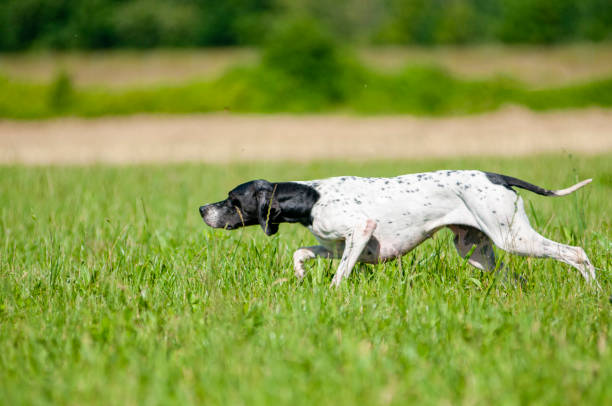English Pointer

Breed History:
The English Pointer, often simply called the Pointer, is one of the oldest and most refined pointing breeds, developed in England during the 17th and 18th centuries. It was bred specifically for bird hunting, with its signature "pointing" stance, where the dog freezes with its body aligned and one paw lifted toward the game, becoming the hallmark of the breed.
Its ancestry likely includes Spanish Pointers, Greyhounds, Bloodhounds, and Foxhounds, combining endurance, speed, and scenting ability. English Pointers were highly valued for their precision in locating game birds and their compatibility with hunters on foot or horseback.
Today, they are still widely used in the field, especially in North America and Europe, where they remain a favourite among upland game bird hunters. The English Pointer has also become a beloved companion, thanks to its affectionate nature and elegant build.
|
Gender |
Height |
Weight |
|
Male |
63–69 cm |
25–34 kg |
|
Female |
61–66 cm |
20–29 kg |
Size – Medium-Large
Life Expectancy: 12–14 years

Breed Appearance:
The English Pointer has an athletic, sleek, and symmetrical build, combining grace and power. Its body is lean yet muscular, designed for speed and stamina. The breed is known for its distinctive head carriage, noble profile, and alert expression.
It has a short, smooth coat that lies close to the body and feels glossy to the touch. Coat colours include liver, lemon, black, or orange, typically with white markings or in solid shades. The ears are thin and dropped, the tail is straight and whip-like, and the nose is broad and well-developed for scent work.
The Pointer’s overall presence is refined yet functional—built to work all day in the field with effortless grace.
Breed Type – Family/Hunting:
Primarily bred for hunting, the English Pointer excels in pointing and retrieving, making it a superb partner in upland bird shooting. At home, it transitions into a loyal and affectionate family companion.
The breed is friendly, even-tempered, and typically gets along well with children and other dogs. While it has a strong prey drive, early socialisation helps ensure polite behaviour around smaller pets. Pointers are not known to be aggressive or territorial, making them poor guard dogs, but excellent family dogs for active households.
They thrive with plenty of attention and do best when integrated into the daily routines of their human companions.

Training:
English Pointers are intelligent, responsive, and eager to learn, especially when training is consistent and reward-based. However, their strong prey drive and natural hunting instincts can sometimes make them easily distracted outdoors.
Early training and socialisation are essential, particularly to help manage their excitement around birds or small animals. They respond well to positive reinforcement, including treats, toys, or praise.
Training should be firm but gentle, as Pointers are sensitive and can shut down with harsh correction. Off-leash recall is crucial if they are to be exercised in open areas due to their tendency to chase scents.
Health & Care:
The English Pointer is generally a healthy breed with few major genetic issues, especially when bred responsibly. Common concerns may include hip dysplasia, epilepsy, and progressive retinal atrophy (PRA). Their short coat makes them susceptible to cuts or abrasions in rough terrain, so routine checks after outdoor activity are recommended.
Their low body fat and short hair make them sensitive to cold weather. In colder climates, they may require dog jackets or shorter outdoor time during winter. Regular vet visits, a balanced diet, and attention to joint health will help ensure longevity.

Living Conditions:
Pointers are best suited to homes with large, secure yards or access to open spaces. They are not ideal for apartment living unless the owner is extremely active and can meet their high exercise demands.
These dogs are happiest when they can run, explore, and engage with their families. They are not well-suited to being left alone for long hours and may develop behavioral issues such as digging or barking when under-stimulated.
Their strong hunting instinct means fenced areas are necessary to prevent roaming or chasing wildlife.
Exercise:
High energy and athleticism define the English Pointer. This breed requires at least 1.5 to 2 hours of vigorous daily exercise, including running, hiking, or interactive games like fetch. Off-leash time in secure areas is especially beneficial to allow them to stretch and follow scents.
Mental stimulation is equally important. Activities such as scent work, agility, or advanced obedience can help focus their minds and reduce restlessness.
Without proper physical and mental outlets, Pointers can become bored and destructive. Consistent daily activity is non-negotiable for their well-being.
Grooming:
The English Pointer’s grooming needs are minimal. Their short, dense coat sheds moderately year-round and benefits from weekly brushing to remove loose hairs and distribute skin oils.
Bathing is only required occasionally unless the dog gets especially dirty. Regular care should include:
-
Ear cleaning (to prevent infections)
-
Nail trimming (every 3–4 weeks)
-
Dental care (brushing a few times a week)
Because of their active outdoor lifestyle, routine checks for ticks, cuts, or paw injuries are important after fieldwork or hikes.

Advantages:
-
Energetic, athletic, and built for performance
-
Friendly and affectionate with families and children
-
Highly trainable with proper motivation and consistency
-
Low grooming needs and easy to maintain
-
Versatile in various dog sports and hunting environments
-
Elegant, noble appearance with a confident gait
Disadvantages:
-
Extremely high exercise needs—unsuitable for sedentary owners
-
Prey drive can lead to chasing or roaming if off-leash
-
Can become anxious or destructive if under-stimulated
-
Not ideal for apartment living without a serious activity commitment
-
Sensitive to cold due to their short coat
-
Requires secure fencing and supervision outdoors







